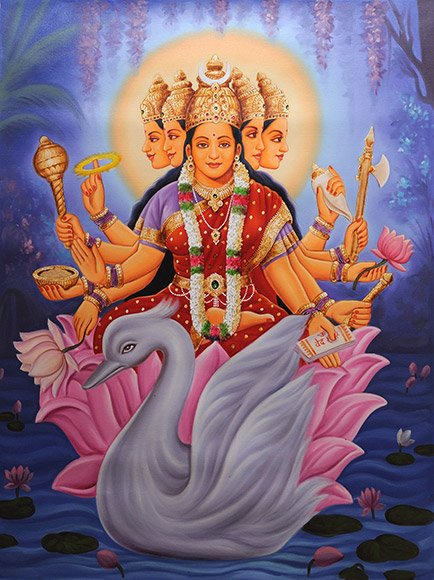Dvipadi, Dvipadī, Dvi-padi: 7 definitions
Introduction:
Dvipadi means something in Hinduism, Sanskrit. If you want to know the exact meaning, history, etymology or English translation of this term then check out the descriptions on this page. Add your comment or reference to a book if you want to contribute to this summary article.
In Hinduism
Chandas (prosody, study of Sanskrit metres)
Source: Shodhganga: a concise history of Sanskrit Chanda literatureDvipadī (द्विपदी) refers to one of the twenty-seven mātrāvṛttas (quantitative verse) dealt with in the second chapter of the Vṛttamuktāvalī, ascribed to Durgādatta (19th century), author of eight Sanskrit work and patronised by Hindupati: an ancient king of the Bundela tribe (presently Bundelkhand of Uttar Pradesh). A Mātrāvṛtta (e.g., dvipadī) refers to a type of metre found in classical Sanskrit poetry.
Source: Journal of the University of Bombay Volume V: Apabhramsa metres (2)1) Dvipadi (द्विपदि) refers to “metres with two lines in a stanza”, as discussed in books such as the Chandonuśāsana, Kavidarpaṇa, Vṛttajātisamuccaya and Svayambhūchandas.—Any dvipadi which is longer than [39 mātrās] and contains 40 or more mātrās in its line is called Mālādhruvaka, according to both Hemacandra and Svayambhū.
2) Dvipadī (द्विपदी) is the name of a catuṣpadi metre (as popularly employed by the Apabhraṃśa bards).—Dvipadī has 28 mātrās in each of its four lines, divided into the groups of 6, 4, 4, 4, 4, 4 and [S] mātrās.

Chandas (छन्दस्) refers to Sanskrit prosody and represents one of the six Vedangas (auxiliary disciplines belonging to the study of the Vedas). The science of prosody (chandas-shastra) focusses on the study of the poetic meters such as the commonly known twenty-six metres mentioned by Pingalas.
Kavya (poetry)
Source: Google Books: Indian Kāvya LiteratureDvipadi or Duvai is the name of a mixed metre used occasionally for an initial refrain to a kaḍavaka. Since its alternate pādas have different rhythms (with 16 mātrās in the odd pādas and 12 in the even) it is possible to explain the name as ‘having two metres (rhythms)’

Kavya (काव्य, kavya) refers to Sanskrit poetry, a popular ancient Indian tradition of literature. There have been many Sanskrit poets over the ages, hailing from ancient India and beyond. This topic includes mahakavya, or ‘epic poetry’ and natya, or ‘dramatic poetry’.
Languages of India and abroad
Sanskrit dictionary
Source: DDSA: The practical Sanskrit-English dictionaryDvipadī (द्विपदी).—a kind of Prākṛta metre.
Dvipadī is a Sanskrit compound consisting of the terms dvi and padī (पदी). See also (synonyms): dvipadikā.
Source: Cologne Digital Sanskrit Dictionaries: Monier-Williams Sanskrit-English Dictionary1) Dvipadī (द्विपदी):—[=dvi-padī] [from dvi-pad > dvi] f. (padī) a kind of Prākṛt metre, [Colebrooke]
2) [v.s. ...] a song composed in this m°, [Kādambarī] (dī-khaṇḍa, [Ratnāvalī i, 12/13; 16/17])
3) [v.s. ...] taking 2 steps, [Āśvalāyana-gṛhya-sūtra i, 7, 19.]
Source: DDSA: Paia-sadda-mahannavo; a comprehensive Prakrit Hindi dictionary (S)Dvipadī (द्विपदी) in the Sanskrit language is related to the Prakrit word: Doaī.
Sanskrit, also spelled संस्कृतम् (saṃskṛtam), is an ancient language of India commonly seen as the grandmother of the Indo-European language family (even English!). Closely allied with Prakrit and Pali, Sanskrit is more exhaustive in both grammar and terms and has the most extensive collection of literature in the world, greatly surpassing its sister-languages Greek and Latin.
Kannada-English dictionary
Source: Alar: Kannada-English corpusDvipadi (ದ್ವಿಪದಿ):—
1) [noun] (pros.) a meter in which each verse has two lines.
2) [noun] (pros.) a meter in which each lines has three groups of five units and one group of three units.
Kannada is a Dravidian language (as opposed to the Indo-European language family) mainly spoken in the southwestern region of India.
See also (Relevant definitions)
Partial matches: Dvi, Padi, Pati.
Starts with: Dvipadika, Dvipadikhanda.
Ends with: Bhaminidirghadvipadi, Ganadvipadi, Svaradvipadi, Vasudvipadi.
Full-text (+77): Dvipad, Dvipadika, Doai, Bharakranta, Vishala, Ardhasama, Shirshaka, Aranala, Kumuda, Ganadvipadi, Revaka, Vasudvipadi, Svaradvipadi, Kancanalekha, Caru, Malayavikasita, Karimakarabhuja, Amarapurasundari, Lalataka, Pushpamala.
Relevant text
Search found 6 books and stories containing Dvipadi, Dvipadī, Dvi-padi, Dvi-padī; (plurals include: Dvipadis, Dvipadīs, padis, padīs). You can also click to the full overview containing English textual excerpts. Below are direct links for the most relevant articles:
Rig Veda (translation and commentary) (by H. H. Wilson)
Rig Veda 1.164.41 < [Sukta 164]
Gati in Theory and Practice (by Dr. Sujatha Mohan)
Importance of Gati in Uparūpakas < [Chapter 3 - Application of gati in Dṛśya-kāvyas]
Gati performed in Dhruvā-gāna < [Chapter 3 - Application of gati in Dṛśya-kāvyas]
Technical terms seen in Uparūpakas < [Chapter 3 - Application of gati in Dṛśya-kāvyas]
The Agnistoma Somayaga in the Shukla Yajurveda (by Madan Haloi)
Part 5.8: Sacrifice of sterile cow (anubandhyā-paśuyāga) < [Chapter 4 - The Agniṣṭoma Ritual]
Cosmetics, Costumes and Ornaments in Ancient India (by Remadevi. O.)
2.18. Dressing on the Basis of Profession < [Chapter 2 - Costumes]
Women in the Atharva-veda Samhita (by Pranab Jyoti Kalita)
11. Goddess Kṛtyā < [Chapter 4 - Female Deities and the Glorification of Women in the Atharvaveda]
Brihadaranyaka Upanishad (by Swāmī Mādhavānanda)
Section XIV - The Sacred Gayatri < [Chapter V]